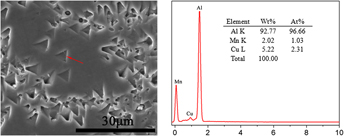Crossref Citations
This article has been cited by the following publications. This list is generated based on data provided by
Crossref.
Shi, Chunchang
Zhang, Liang
Wu, Guohua
Zhang, Xiaolong
Chen, Antao
and
Tao, Jiashen
2017.
Effects of Sc addition on the microstructure and mechanical properties of cast Al-3Li-1.5Cu-0.15Zr alloy.
Materials Science and Engineering: A,
Vol. 680,
Issue. ,
p.
232.
Chen, Antao
Zhang, Liang
Wu, Guohua
Sun, Ming
and
Liu, Wencai
2017.
Influences of Mn content on the microstructures and mechanical properties of cast Al-3Li-2Cu-0.2Zr alloy.
Journal of Alloys and Compounds,
Vol. 715,
Issue. ,
p.
421.
Brice, Craig A.
Tayon, Wesley A.
Newman, John A.
Kral, Milo V.
Bishop, Catherine
and
Sokolova, Anna
2018.
Effect of compositional changes on microstructure in additively manufactured aluminum alloy 2139.
Materials Characterization,
Vol. 143,
Issue. ,
p.
50.
MacRae, Colin M.
Hughes, Anthony E.
Laird, James S.
Glenn, A. M.
Wilson, Nicholas C.
Torpy, Aaron
Gibson, Mark A.
Zhou, Xiaorong
Birbilis, Nick
and
Thompson, George E.
2018.
An Examination of the Composition and Microstructure of Coarse Intermetallic Particles in AA2099-T8, Including Li Detection.
Microscopy and Microanalysis,
Vol. 24,
Issue. 4,
p.
325.
Shi, Chunchang
Wu, Guohua
Zhang, Liang
and
Zhang, Xiaolong
2018.
Al–5.5Mg–1.5Li–0.5Zn–0.07Sc–0.07Zr alloy produced by gravity casting and heat treatment processing.
Materials and Manufacturing Processes,
Vol. 33,
Issue. 8,
p.
891.
Peng, Zhuowei
Pan, Qinglin
Cai, Shan
Li, Jinfeng
and
Liang, Wenjie
2019.
Effect of different aging processes on the corrosion behavior of new Al–Cu–Li–Zr–Sc alloys.
Materials and Corrosion,
Vol. 70,
Issue. 12,
p.
2266.
Wu, Guohua
Shi, Chunchang
Zhang, Liang
Liu, Wencai
Chen, Antao
and
Ding, Wenjiang
2020.
Effect of Different Ageing Processes on Microstructure and Mechanical Properties of Cast Al–3Li–2Cu–0.2Zr Alloy.
Acta Metallurgica Sinica (English Letters),
Vol. 33,
Issue. 9,
p.
1243.
Li, Chao
Li, Ming
Yin, Shaokun
Zeng, Liang
and
Zhang, Lei
2021.
Electrochemical performance enhancement by the partial reduction of NiFe2O4@g-C3N4 with core-shell hollow structure.
Journal of Alloys and Compounds,
Vol. 861,
Issue. ,
p.
157986.
Chandra Mohan, Heggedehalli Krishnappa
Devaraj, Sonnappa
Narayana Swamy, Kalavara Saddashiva Reddy
and
Venkatesha, B.K.
2022.
Mechanical and Tribological Properties Correlations of Die Cast and Spray Formed Aluminum 2.5wt.% Cu-2.5wt.% Mg - 5wt.% Zn Alloy.
Solid State Phenomena,
Vol. 340,
Issue. ,
p.
71.
Adjei-Kyeremeh, Frank
Pratesa, Yudha
Shen, Xiao
Song, Wenwen
Raffeis, Iris
Vroomen, Uwe
Zander, Daniela
and
Bührig-Polaczek, Andreas
2023.
Preheating Influence on the Precipitation Microstructure, Mechanical and Corrosive Properties of Additively Built Al–Cu–Li Alloy Contrasted with Conventional (T83) Alloy.
Materials,
Vol. 16,
Issue. 14,
p.
4916.





